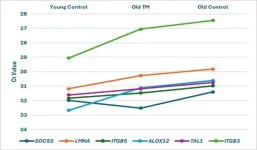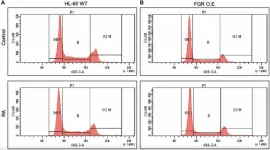New study links lower proportions of certain sleep stages to brain changes associated with Alzheimer’s disease
Research shows reduced neuroactivity during sleep is associated with brain atrophy in areas vulnerable to Alzheimer’s disease
2025-03-31
(Press-News.org) DARIEN, IL — New research reveals that lower proportions of specific sleep stages are associated with reduced brain volume in regions vulnerable to the development of Alzheimer’s disease over time.
Results show that individuals with lower proportions of time spent in slow wave sleep and rapid eye movement sleep had smaller volumes in critical brain regions, particularly the inferior parietal region, which is known to undergo early structural changes in Alzheimer’s disease. The results were adjusted for potential confounders including demographic characteristics, smoking history, alcohol use, hypertension, and coronary heart disease.
“Our findings provide preliminary evidence that reduced neuroactivity during sleep may contribute to brain atrophy, thereby potentially increasing the risk of Alzheimer’s disease,” said lead author Gawon Cho, who has a doctorate in public health and is a postdoctoral associate at Yale School of Medicine in New Haven, Connecticut. “These results are particularly significant because they help characterize how sleep deficiency, a prevalent disturbance among middle-aged and older adults, may relate to Alzheimer’s disease pathogenesis and cognitive impairment.”
The study was published March 31 as an accepted paper in the Journal of Clinical Sleep Medicine, the official publication of the American Academy of Sleep Medicine.
According to the Alzheimer’s Association, Alzheimer’s disease is a degenerative brain disease and the most common cause of dementia. An estimated 6.7 million Americans aged 65 and older are living with Alzheimer’s disease, and this number is projected to double by 2060, pending medical developments to prevent, slow or cure the disease.
The study involved an analysis of data from 270 participants who had a median age of 61 years. Fifty-three percent were female, and all participants were white. Individuals were excluded from the analysis if they previously had a stroke or probable dementia or other significant brain pathology. The research utilized polysomnography to assess baseline sleep architecture. Advanced brain imaging techniques were used to measure brain volumes 13 to 17 years later.
According to the authors, the study demonstrates an important association between sleep and long-term brain health, and it highlights potential opportunities to reduce the risk of Alzheimer’s disease.
“Sleep architecture may be a modifiable risk factor for Alzheimer’s disease and related dementias, posing the opportunity to explore interventions to reduce risk or delay Alzheimer’s onset,” said Cho.
The researchers emphasized that further investigation is needed to fully understand the causal relationships between sleep architecture and Alzheimer’s disease progression.
# # #
END
ELSE PRESS RELEASES FROM THIS DATE:
2025-03-31
A collaborative study conducted by researchers at Maharishi International University (MIU), the University of Siegen, and the Uniformed Services University of the Health Sciences reveals that individuals practicing Transcendental Meditation® (TM®) technologies long-term show favorable biological markers of aging and stress. The research compared gene expression, cognitive function (via EEG), and hair glucocorticoids (cortisol and cortisone) in 12-year and 40-year TM groups and non-meditator controls.
“This study provides evidence that long-term practice of TM technologies has a broad range of health benefits at the molecular ...
2025-03-31
EMBARGOED UNTIL MONDAY, MARCH 31 – 11:00 AM Eastern
The nuclei in our cells are miniature warehouses safeguarding the genetic blueprint for the body’s biologic machinery.
As warehouses go, nuclei are more like libraries than bank vaults. Too many cellular components need access to the genome to lock it down like Fort Knox. Instead, large groupings of more than 1,000 individual protein molecules called nuclear pore complexes (NPCs) pepper the dividing membrane, serving as gateways for materials and messages entering and exiting the nucleus.
While the basic need for this shuttle service is constant, ...
2025-03-31
About The Study: Hormonal contraceptive initiation postpartum was associated with an instantaneous increased risk of developing depression in this cohort study. The associated risk was higher the earlier it was initiated postpartum, at least for combined oral contraceptives. This finding raises the issue of whether the incidence of depression postpartum is increased by routine hormonal contraceptive initiation after childbirth.
Corresponding Author: To contact the corresponding author, Vibe Gedsø Frokjaer, PhD, email vibe.frokjaer@nru.dk.
To access the embargoed study: Visit our For The Media website at this link https://media.jamanetwork.com/
(doi:10.1001/jamanetworkopen.2025.2474)
Editor’s ...
2025-03-31
When a critically injured patient is admitted to the hospital, how much supplemental oxygen should they receive? New research published this week in JAMA Network Open led by investigators at the University of Colorado School of Medicine suggests it’s often less than the current standard.
“The idea has traditionally been that severe trauma causes stress to patients’ bodies, and we want to deliver as much oxygen as possible to the brain and to vital organs because they are losing blood,” says Adit Ginde, MD, MPH, professor ...
2025-03-31
Marking a breakthrough in the field of brain-computer interfaces (BCIs), a team of researchers from UC Berkeley and UC San Francisco has unlocked a way to restore naturalistic speech for people with severe paralysis.
This work solves the long-standing challenge of latency in speech neuroprostheses, the time lag between when a subject attempts to speak and when sound is produced. Using recent advances in artificial intelligence-based modeling, the researchers developed a streaming method that synthesizes brain ...
2025-03-31
Scientists at the National Center for Supercomputing Applications and the University of Illinois College of Medicine Peoria (UICOMP) were authors of a research paper published in the Journal of Acoustical Society of America Express Letters that demonstrates improved, automated screening methods for anxiety and major depressive disorders.
In the project titled, “Automated acoustic voice screening techniques for comorbid depression and anxiety disorders,” Mary Pietrowicz, along with colleagues from the University of Illinois Urbana-Champaign and UICOMP, explored how machine ...
2025-03-31
“This study reveals that the expression of the Src-family kinase (SFK), FGR, alone can induce cell differentiation similar to RA.”
BUFFALO, NY – March 31, 2025 – A new research paper was published in Oncotarget, Volume 16, on March 21, 2025, titled “FGR Src family kinase causes signaling and phenotypic shift mimicking retinoic acid-induced differentiation of leukemic cells.”
A research team led by first author Noor Kazim and corresponding author Andrew Yen from Cornell University discovered that the FGR protein—traditionally ...
2025-03-31
WASHINGTON— In a review published today in the peer-reviewed journal Oxford Open Climate Change, top scientists issued an urgent warning that fossil fuels and the fossil fuel industry are driving interlinked crises that threaten people, wildlife, and a livable future.
Today’s review synthesizes the extensive scientific evidence showing that fossil fuels and the fossil fuel industry are fueling not only the climate crisis but also public health harms, environmental injustice, biodiversity loss, and the plastics ...
2025-03-31
One of the ocean currents in the Arctic Ocean is at risk of disappearing this century because of climate change, according to a new joint study from the University of Gothenburg and the German Alfred Wegener Institute. As a result, the North Atlantic could be flooded with freshwater which would weaken the global ocean circulation.
The weakening of the AMOC, Atlantic Meridional Overturning Circulation, is a hot topic among the world's climate scientists. However, it is unclear what the consequences will be when ...
2025-03-31
BOSTON - March 31, 2025 - A memory is not a straight line from one point to another, even if we sometimes think of them like linear stories. This key insight that cognitive neuroscientists have known for many years is now guiding a new type of research—to explore not only how memories evolve over time but also how they can be strengthened or changed. Assisting researchers with this new exploration is a powerful tool: smartphones.
“Smartphones are an incredible tool for understanding patterns of feelings, behavior, ...
LAST 30 PRESS RELEASES:
[Press-News.org] New study links lower proportions of certain sleep stages to brain changes associated with Alzheimer’s disease
Research shows reduced neuroactivity during sleep is associated with brain atrophy in areas vulnerable to Alzheimer’s disease



